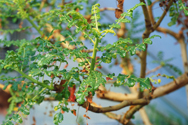
Photo © Steven Foster
Introduction
Frankincense is a resinous, evergreen tree that can grow to 15 feet with papery, peeling bark.1 Five petaled, creamy-white flowers appear in the spring followed by 3 to 5 angled, red-brown capsules. While both species of frankincense are native to the tropical regions of Africa, Asia and Arabia,1 B. serrata also grows on dry hilly areas throughout most of India.2 The gum resin is collected all year and used fresh or dried.1 History and Cultural Significance
Historically, frankincense was used by Jews as a ceremonial incense.3 In Persia, Babylon and Assyria, frankincense was common in religious use. Among the Romans, frankincense was used in religious ceremonials, in domestic life and on state occasions.3 Both B. sacra and B. serrata have been used in cosmetics since the earliest times.1 A black powder, kohl, was made of charred frankincense and used by the Egyptian women to paint their eyelids.3 B. sacra has also been used by the Egyptians in rejuvenating face masks.3 Frankincense has been melted to make hair removal creams,4 and used as a paste to perfume the hands,3 clothes, hair and rooms.2 During the tenth century, frankincense was recommended for fevers and ulcers.4 In India, different parts of B. serrata tree were used traditionally in Ayurvedic medicine for asthma, blood purification, bronchial conditions, rheumatism and wounds.2 Historically, Chinese medicine has also used B. sacra internally for menstrual pain and injuries, and as a wash for mouth, gum and throat complaints.1 Skin care products contain frankincense for use on, dry and mature complexions. It is also used in aromatherapy. Modern Research
Recent studies have been performed on B. serrata gum resin for its potential use in chronic inflammatory diseases.5 Other studies have investigated herb-mineral formulations of B. serrata for the same properties with promising results.6 Future Outlook
In Northern Somalia, gum farm ownership has become very complex. In 1840, ownership of gum farms was allocated to local families by the ruling sultan.7 Ownership has been passed down to successive male descendants and only gives the owners rights to the stand of trees and not the land that the trees are on.7 Frankincense harvesting in Somalia functions within extended family structures, clans, and sub-clans.7 Collectors may have to share revenues with owners/co-owners of the plantations or they may enjoy 100% of the returns, depending on the plantation area. Northern Somalia has approximately 10,000 frankincense collectors.7 Gum trading is dominated by the clan-based merchants.7 For the future, a reliable clan merchant will be the source of supply for frankincense gum until collectors are organized to trade independently.7 As of 2003, Somali did not have good quality control systems in place for gum export or direct access to international and Saudi Arabian markets.7 Therefore, Somalis have had to become dependent on Gulf transhipment markets. Somali frankincense demand and price have dropped since merchant cartels are now in control of the international frankincense trade.7 References
1 Bown D. The Herb Society of America New Encyclopedia of Herbs and Their Uses. London: Dorling Kindersley Limited; 2001. 2 DerMarderosian A, Beutler J, editors. The Review of Natural Products. 3rd ed. St. Louis, MO: Facts and Comparisons; 2002. 3 Lawless J. The Encyclopedia of Essential Oils: The Complete Guide to the Use of Aromatics in Aromatherapy, Herbalism, Health, & Well-Being. Dorset, UK: Element Books Ltd; 1992. 4 Grieve M. A Modern Herbal. Vol I. New York: Dover Publications; 1971. 5 Ammon H. Boswellic acids (components of frankincense) as the active principle in treatment of chronic inflammatory diseases[in German; English abstract]. Wien Med Wochenschr. 2002;152(15-16):373-8. 6 Kulkarni R, Patki P, Jog V, Gandage S, Patwardhan B. Treatment of osteoarthritis with a herbomineral formulation: a double-blind, placebo-controlled, cross-over study. J Ethnopharmacol. 1991 May-June;33(1-2):91-95. 7 Frankincense Our Friend. 2003. Available at: http://www.pinterventions.org/somali_frankincense_part4.htm. Accessed March 8, 2005.
|